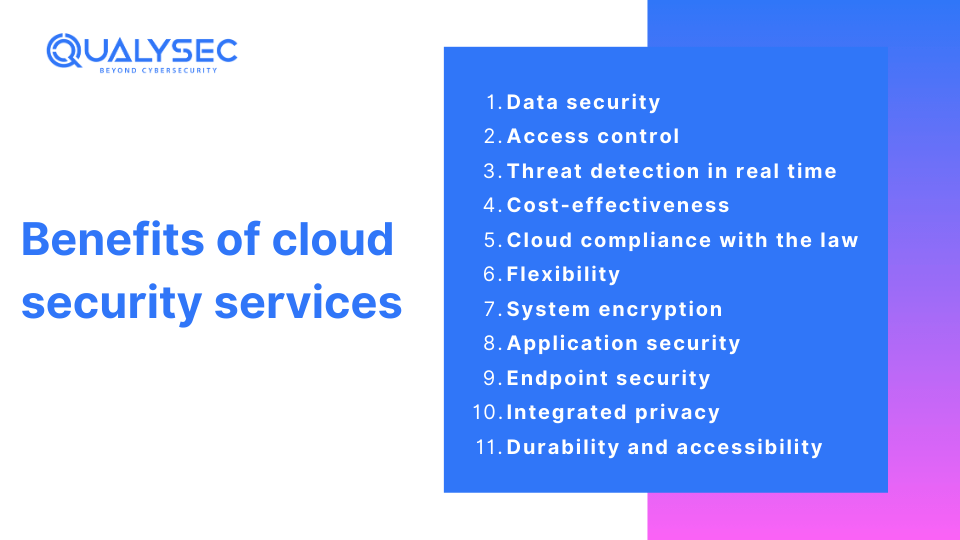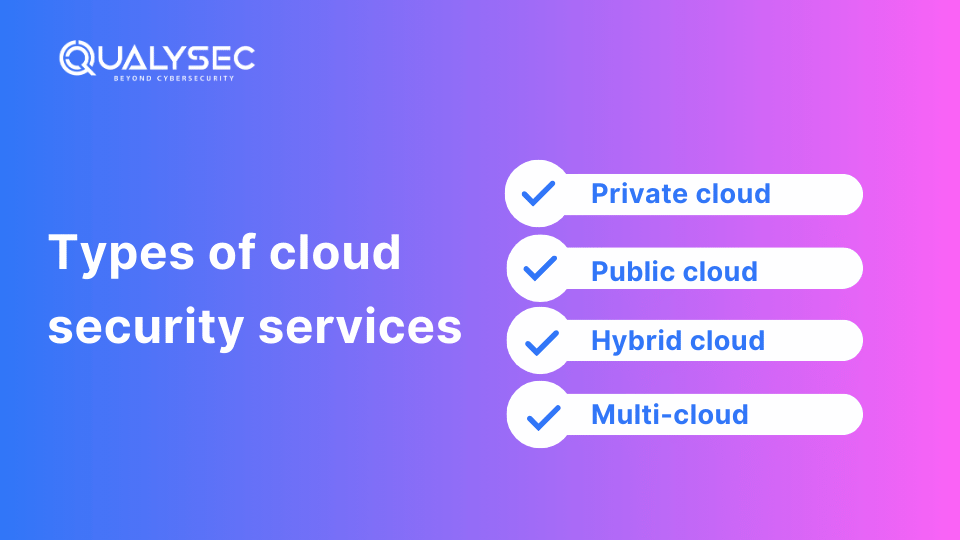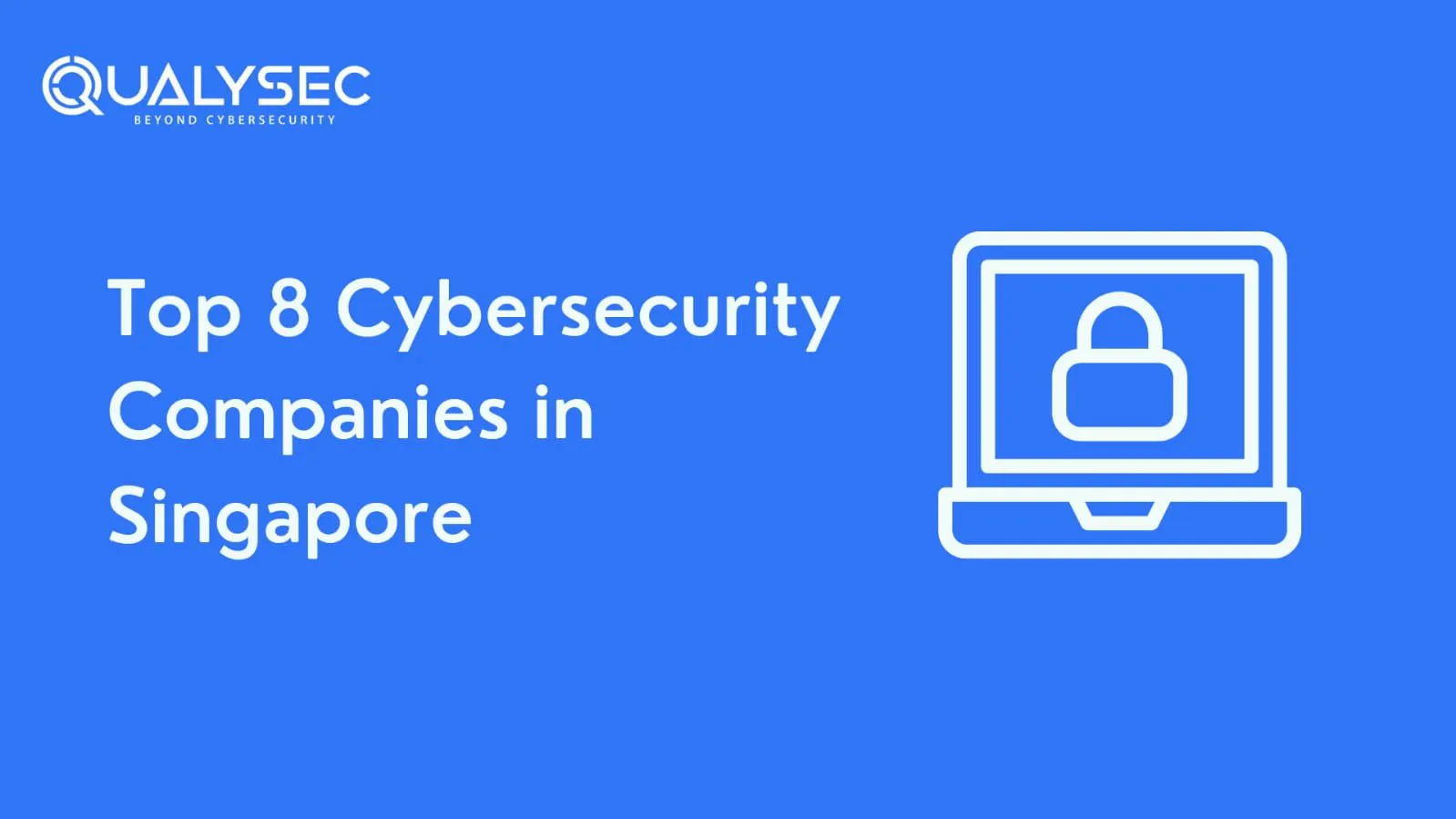The phrase “cloud security service” refers to a broad range of methods and protocols intended to safeguard data stored in the cloud. In addition to ensuring regulatory compliance and repelling possible attacks, these policies safeguard networks, user data, and the apps themselves. Keeping important data in the cloud instead of a physical device provides multiple layers of security to secure user and business data.
Businesses are coming up with new and improved methods to store data in the constantly evolving digital ecosystem. People increasingly store information in the cloud rather than on specific devices or in physical data centers. Regardless of a user’s location or device, cloud-based technology provides flexible access at any time and from any location.
What Is Cloud Security Service?
Cloud security service refers to a set of security rules, processes, tools, and technologies used to safeguard people, confidential information, applications, and architecture in cloud-based computing environments. The most complete cloud security solutions shield SaaS resources, users, and workloads from malware, data breaches, and other security risks.
Businesses that use cloud security services understand how important it is to keep data, apps, and client information secure. Customers will lose faith in your ability to protect their information if an invasion of privacy or attack is successful, which can hurt an organization’s image and financial performance. Although the use of cloud services has many benefits, there are also new risks associated with it. Cybersecurity is essential and there are significant cloud security benefits and challenges that every organization should consider.
Why is cloud security important?
Older networking architectures, which prioritized local people and resources, have become less safe and inefficient due to the increasing dispersion of workers, data, and cloud-based applications. To compensate for the declines in protection, efficiency, and customer loyalty, companies must reevaluate their environmental protection strategies. In the modern, innovative, and cybercrime-shadowed economy, enterprises need the capacity and adaptability of cloud services, which can only be successfully protected by cloud security services that adapt to the particular requirements of the cloud.
What are the benefits of cloud security services?
Putting cloud security measures into effect guarantees the following:
- Data security: By eliminating the loss of information and controlling access, cloud security solutions are made expressly to guarantee data security. Confidential information is shielded from unwanted access while in motion and at repose.
- Access control: Multi-factor authentication is used by cloud security services to guarantee that only authorized users can access the cloud.
- Threat detection in real time: To defend against cyberattacks like DDoS and SQL injections, modern CSPs offer automatic alarms and continuous surveillance.
- Cost-effectiveness: Cloud security enables businesses to do away with the expenses associated with establishing and maintaining an intricate on-premise security architecture. Rather, CSPs manage this in compliance with the most severe industry standards.
- Cloud compliance with the law: Cloud safety measures frequently meet business and international regulatory standards. However, since regulations are always changing, firms need to be on the lookout.
- Flexibility: Regardless of the size of the company, cloud security services are simple to adapt. Without significantly altering the cloud architecture, safety measures are extended as needed to incorporate an expanding system.
- System encryption: Using firewalls, encryption, and virtual private networks (VPNs), cloud security service guarantees to secure data transfer between endpoints and servers.
- Application security: Firewalls and vulnerability scanning are used to safeguard user data in applications.
- Endpoint security: To provide safe access to the cloud, cloud security service safeguards endpoint devices including laptops, tablets, and smartphones.
- Integrated privacy: From a single location, cloud monitoring solutions examine possible risks to several businesses. This makes it possible to secure protection on all devices, create plans for recovery from emergencies, and install applications on time.
- Durability and accessibility: Cloud security maintains sustainability by keeping cloud services functional even if certain components fail.
What are the types of cloud security services?
Here are the categories of cloud security:
- Private cloud: Specialized technology utilized by a single organization that is either owned by the business or an outside organization and is in charge of managing its safety and security. Governments, financial institutions, and others with sensitive data to secure are among the most prevalent consumers.
- Public cloud: Third-party system that is shared by several businesses, each of which shares security obligations with the provider in accordance with the shared responsibility paradigm. Worldwide, a lot of people use public cloud services like Microsoft 365 and Google Workspace.
- Hybrid cloud: a mixture of public as well as private implementations where a company employs each for its advantages, including stricter controls (private cloud) or flexibility (public cloud). DevOps teams and other groups requiring adaptable, adjustable solutions are frequent users.
- Multi-cloud: Common structures, typically utilized by businesses that have similar categorization and privacy needs (e.g., PCI DSS) and/or require access to particular applications. To access the services of several suppliers, businesses all over the world employ multi-cloud setups.
Additionally, there are four primary cloud service models:
- SaaS: Full software packages, either free or paid, that are provided over the cloud (e.g., Google Docs)
- PaaS: Tools from the cloud that developers can use to create, test, and launch apps in a scalable setting
- IaaS: Third-party managed virtualized infrastructure that an enterprise can deploy applications on
- FaaS: Like PaaS, but tailored to certain app functionalities that can be swiftly scaled up or down.
How does cloud security work?
Since a cloud environment is only as secure as its most vulnerable component, a combination of technologies is necessary for effective cloud security to safeguard data and apps from all potential threats. Firewalls, identity and access management (IAM), categorization, and encryption are frequently included in this.
Cloud security service safeguards data and resources separately as opposed to a boundary. This entails putting in place more detailed security measures, like compliance tools, safeguarding information, data security, backups, and cloud security posture management (CSPM).
Numerous internal and external vulnerabilities can exist in cloud infrastructures, particularly in hybrid clouds that blend private data centers with public clouds. To maintain their accessibility and security, it is crucial to use tools like management of configurations, data encryption, data protection, authentication using multiple factors, and access controls.
Talk to our Cybersecurity Expert to discuss your specific needs and how we can help your business.
Common cloud security threats and solutions
- Misconfigurations: Businesses have several noteworthy obstacles in the swift transition to cloud computing. The biggest risk to cloud security at the moment is misconfiguration. Customers who prioritize a quick transition when transferring information to the cloud frequently overlook the need to implement particular security measures that prevent data from ending up in the wrong individuals.
- Unauthorized Access: Checking too many boxes when granting users authorization can also result in security risks. You can be specific about the kind of access you grant in the cloud. However, for ease, clients frequently provide too many permissions. These broad permissions have the potential to provide the wrong people access to private information. Customizing rights is one advantage of cloud security, but for that adaptation to function properly, careful planning must be done beforehand.
- Unsafe APIs or connections: A degree of shared accountability between customers and cloud providers is assumed by cloud security. The programmers are in charge of writing proper code and adding sufficient security layers. Nevertheless, the client’s use of cloud storage must likewise protect data.
- External Data Exchange: When data is shared outside, it is considerably easier for unauthorized individuals to obtain sensitive information due to the cloud’s increased accessibility.
Key Security Measures in Cloud Environments
The goal of cloud security is to safeguard data at every level, not just the periphery. Among the most widely used measures are:
- Identity and Access Management (IAM): In cloud contexts, identity and access management (IAM) facilitate service management. IAM also aids in preventing unwanted usage of cloud-shared structures, applications, and information.
- Data Loss Prevention (DLP): It keeps an eye on and examines data to stop it from being exfiltrated. DLP is a crucial component of cloud-based security that cannot be adequately implemented by a traditional security approach.
- Data Encryption: Encrypting data prevents hackers from deciphering it without first decrypting it. In addition to maintaining anonymity and fostering trust, encryption is mandated by numerous privacy laws across the globe.
- Security Information and Event Management (SIEM): Your security team will have more visibility into your cloud ecosystem thanks to security information and event management (SIEM), which analyzes security records in real time.
These are fundamental security technologies, but cloud security has had to change to stay up with today’s astute threat actors and expanding compliance needs.
Types of Cloud Security Solutions
In order to maintain secure cloud services, CSPs and clients collaborate to develop robust solutions that safeguard their resources in the cloud.
You may secure your cloud using the following typical types of Cloud security services or solutions:
1. CASB, or Cloud Access Security Broker:
A security policy enforcement point called CASB is established between cloud service suppliers and customers. It is in charge of ensuring that users who access cloud-based resources adhere to company security regulations. A variety of security policy types can be handled by CASB.
2. Posture Management for Cloud Security (CSPM):
Organizations may evaluate and control the security posture of their cloud infrastructure with the use of CSPM solutions. They provide repair advice to preserve a safe environment after identifying cloud resource vulnerabilities, misconfigurations, and compliance violations. To help you set up and optimize Google Cloud’s Security Command Center Premium (SCCP) in compliance with best practices, SADA provides a CSPM solution that integrates with your current setup.
3. Platforms for Cloud Workload Protection (CWPP):
Cloud-based workloads and apps are the main emphasis of CWPP solutions. By keeping an eye on and protecting cloud-based apps and data, they provide defense against malware, infiltration attempts, and data breaches.
4. Compliance with Cloud:
Solutions for cloud compliance assist businesses in meeting industry-specific and legal security standards. To make sure cloud operations adhere to the required standards, they automate audit trails, report production, and compliance checks.
5. Security Information and Event Management (SIEM) systems:
SIEM (Security Information and Event Management) solutions gather and analyze safety information from several sources, including cloud-based settings, to identify and address security problems. These systems can do immediate time risk monitoring, schedules, and forensic investigations.
6. XDR, or Extended Response and Detection:
Compared to traditional threat detection, XDR systems offer a more comprehensive view of security threats by integrating data from several security sources, including cloud resources. They increase the organization’s total capacity for threat detection and response.
7. SASE, or Secure Access Service Edge:
Wide-area networking (WAN) and network security are combined into a cloud-based service called SASE. By combining networking and security features, it enables safe remote access to cloud resources and apps.
8. Service Edge Security (SSE):
SSE provides security services near users and devices, extending security protections to the network’s edge. It improves protection for distributed systems by offering reliable security for both on-premises and cloud resources.
Choosing the Right Cloud Security Provider
The most important decision for any company looking to make use of cloud computing without endangering its data and assets is choosing a secure cloud security service provider. Cloud security of platforms is more than just technological controls and functionality. Compliance, trust, and openness should also be taken into consideration. Cloud computing services and cloud-based technologies are being used by businesses more and more these days for data management.
How does Qualysec help you to secure your cloud environments?
Offering complete cloud security services that strengthen your cloud infrastructure and protect your priceless assets is our area of expertise at Qualysec. To give your cloud-based systems the best protection possible, our team of professional cloud security experts uses advanced technologies, top-of-the techniques, and extensive knowledge. Additionally, Qualysec provides a wide range of services, such as:
- Web App Pentesting
- Mobile App Pentesting
- API Pentesting
- Cloud Security Pentesting
- IoT Device Pentesting
- Blockchain Pentesting
Our ability to serve our customers is something we at Qualysec are proud of. With our outstanding services, we aim to surpass standards and place a high priority on client happiness. We have a reputation for creating happy customers because of our commitment to providing top-notch solutions and attending to each individual client’s demands. We are grateful for the confidence that has been placed in us, and we will do everything in which we can ensure our clients complete comfort and satisfaction.
Conclusion
Cloud security services are important for protecting data, apps, and systems in the cloud and guaranteeing that clients get the most out of their investments. Organizations can protect their cloud environments from the negative consequences of cybercrime by adhering to industry standards, security procedures, and current trends. As new risks and possibilities arise as technology develops, cloud security services continue to provide useful security features that let users take advantage of the cloud’s advantages while remaining completely safe.
FAQ
Q. What are the top 5 security in cloud computing?
Ans: The following are the top five cloud computing safety measures and technologies:
- Management of Identity and Access (IAM)
- In-transit and at-rest data encryption
- Configurations for Network Security and Firewalls
- SIEM, or Security Information and Event Management
- Monitoring and Compliance (Ongoing Monitoring)
Q. What is the difference between cybersecurity and cloud security?
Ans: Despite their close connection, cybersecurity and cloud security concentrate on distinct facets of technological security:
The protection of systems, networks, and data in all settings, including locally, cloud, and hybrid infrastructures, is included in the vast field of cybersecurity. Regardless of the location of the valuables, its objective is to protect against all forms of cyber threats.
A branch of cybersecurity known as “cloud security” is dedicated to protecting information, programs, and services in cloud settings. It entails safeguarding cloud infrastructure, guaranteeing safe access, and controlling risks and vulnerabilities unique to the cloud.
Q. What are the main challenges in cloud security?
Ans: Cloud security provides distinctive problems due to the fact that of shared assets, unauthorized access, and cloud-specific threats. The following are some of the main obstacles:
- Data loss and data breach
- Cloud Settings Misconfiguration
- Insufficient Control and Visibility
- Regulatory and Compliance Concerns
- Internal Threats
- Insecure Interfaces and APIs
- Unauthorized Access and Account Hijacking
- The intricacy of multi-cloud and hybrid environments.
- DoS attacks, or denial of service



































































































































































































































































































































0 Comments